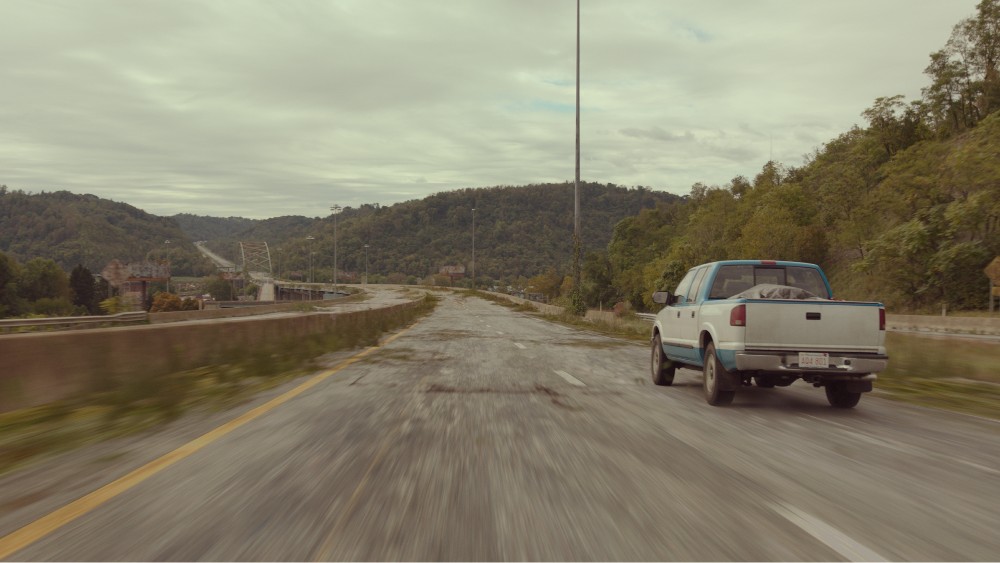
Mitch S. Drain has been working in visual effects for thirty years, literally starting at a time that could have been considered the heyday of when visual effects were becoming prevalent in Hollywood blockbusters like Roland Emmerich’s Independence Day.
Recently, Drain was called upon, through his role as VFX Supervisor at Digital Domain, to help create the environments for HBO’s The Last of Us, a world that has been left abandoned and forgotten for 20 years as a virus overcomes the earth’s population. It’s a VFX job that could be considered more “supporting,” but it’s also crucial to the look and feel of a show that takes place in a very different version of our own world, one that’s heavily informed by the hugely-popular Naughty Dog video game, written by Neil Druckman (who was also heavily involved with creating the show.)
Drain was also recently the main VFX supe for the Netflix movie, Chupa, directed by Jonas Cuaron, a gig that required Drain to create a lovable version of a normally-frightening mythological Mexican chupacabra creature for what is essentially a family film.
Below the Line had a chance to speak with VFX vet Drain over Zoom a few weeks back.
[Note: This interview has been edited for clarity and length]
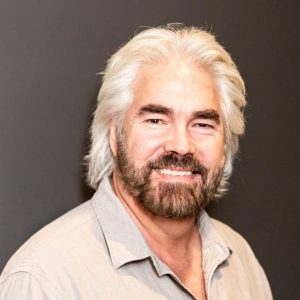
Below the Line: I was reading your bio, and you’ve been working in VFX for quite some time.
Mitch Drain: I don’t even want to tell you how long. I go back to the old days of matte paintings on glass and photochemical processes, so yeah, I’ve done a little bit.
BTL: Have you been at Digital Domain since they started thirty years ago?
Drain: No, actually, on the scale of time, I’m probably a relatively new member. I started in 2018 at DD, and it’s been a good run.
BTL: Before that, were you at another VFX house of freelancing?
Drain: Over my career, I’ve really made the rounds. I was freelance before DD — did a couple shows as a freelance supervisor. Before that, I was at a company called Shade VFX. Before that, I was at a company called Asylum. Before that, I was at Centropolis, I used to work for Roland Emmerich and Dean Devlin back in the ’90s and the early 2000s. I’ve made the rounds; I was at Method for a little while.
BTL: I’ve spoken to Roland before, and I know his movies tend to push the envelope on the VFX.
Drain: It was a great trial by fire. That was pretty early in my career, with Stargate, Independence Day, and Godzilla and all that stuff. It was great. I loved working for Roland.
BTL: Let’s talk about The Last of Us. How long ago did you get involved with that and how far before production started?
Drain: Well, Digital Domain got involved quite early. They did previs for the show, and I wasn’t a part of that. That was a different department within the company. Last year, it was a huge year for DD. We were very busy, and there was a limited amount of work that they were able to accept. What ultimately ended up happening is the show got moving, and the show was already in post. They just had a 911, basically. “We have to deliver pretty soon. We got a lot of work left to be done.”
Alex Wang, the supervisor, was very familiar with DD. They had worked with us on the previs, so it was kind of a natural fit for them to come back and say, “This is what we got. How much of this can you do?” It was a nice position to be in. We could pick the work that we felt we could excel in, that would work best with the resources we had.
BTL: They had already shot stuff or they were in the middle of the shoot?
Drain: They had already shot. I think they were just finalizing some of the VFX plate photography and gathering some data when we got involved, which was September of last year, if I’m remembering correctly. We just we hit the ground running, and it was a great project for all of us.
BTL: The VFX reel is great. It really shows you what was there, and what DD added. Were there things in the shots that you had to take out, as well as aging things?
Drain: Not so much. We did a bunch of covering things perhaps, but it was really about taking what was there naturally, and just aging it 20 years. That can mean a whole lot of different things. Is it dilapidated? Is it not? The philosophy from the showrunners and from Alex was that nature is reclaiming all these places now. The man-made parts of it are getting ugly and dilapidated and decayed while nature is thriving.
One thing that I thought was different about this work was that there is supposed to be a certain amount of beauty in it, in that nature is taking over. The greens are green and beautiful, and there are flowers. Roads are getting overtaken but they’re not getting overtaken by nasty weeds. They’re getting overtaken by overgrowth of Bougainvillea. Conversely, things like signage. At one point, they drive by a FedEx parking lot or a restaurant sign, the manmade stuff is all being overtaken and decayed and broken. You had that nice dichotomy between the decayed stuff, and then the beautiful stuff.
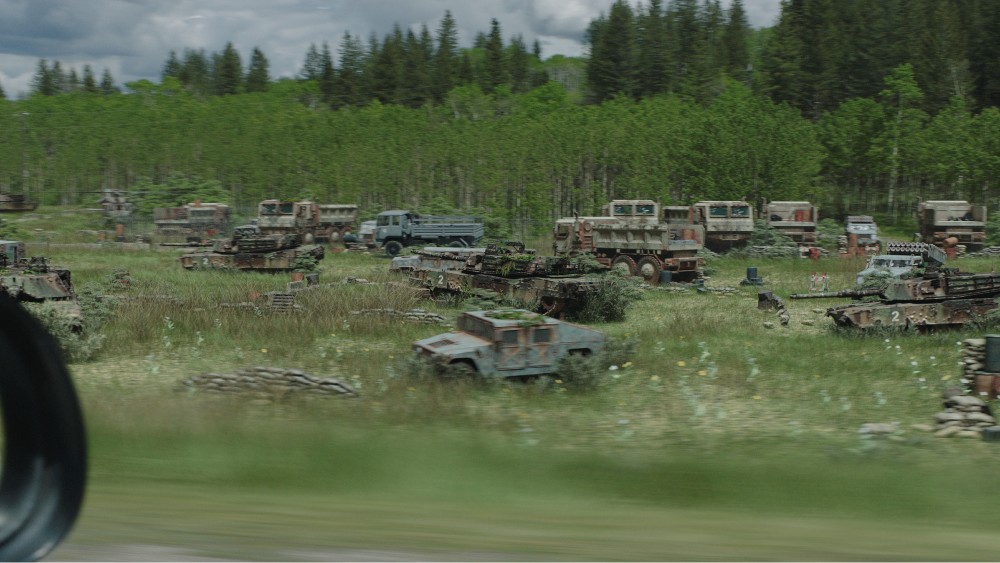
BTL: What is “Bougainvillea”?
Drain: It’s a beautiful purple, tumbling, flower leaf plant. There were other ones, but that particular species of plant was commonplace and was used quite a bit in other parts of the show, again, just to show the beauty part of it.
BTL: As far as doing the research, do you have that aspect where you go out at things like that just to see how they grow and behave?
Drain: Oh, definitely. For the show, we were supplied imagery from the game, and it gave us a baseline of the balance that they might be looking for. Alex and the showrunners, all gave us a wide berth to, to come up with what we’re going to do with these shots. They had concept art, in some cases, saying, “Okay, this is where we are hoping to go, but we want to take this a little further. We’d like to come up with something more interesting for this field of tanks. See what you can come up with.” I got together with Krista McLean, who is our environments lead supervisor. Honestly, she did most of the heavy lifting on the show, to be completely forthright about it.
We would start researching different types of boats and different kinds of landmarks and the way things would decay, and how overgrowth might look for real, and then, basically put all this stuff together and give a concept back and say, “What do you think?” To our surprise, they were very happy with what we were putting forward.
Usually, there’s a lot of round-robin, back and forth – “We like this, we don’t like that.” To be sure, there was a little bit of that, but we got into a groove with them very quickly, and we were very happy about that – I feel like we were speaking the same language.
BTL: I speak with the VFX supes at Weta a lot, and I’m always curious about putting together a team from the vast number of animators and artists they have there. With a game like this, it probably wasn’t hard to find people there who wanted to work on it.
Drain: No, and some of the other artists on the environment team, who did understand the game, know the game, and some of the compositors, they brought that to the work. We had a great collaborative team of people, and everybody had ideas. No one idea was better or worse than another one, but someone might say, “Well, this looks great, but it’s gotta be more true to the spirit of the game. What do you say we take a look at this?” and I’d be, “Of course, let’s do that.” We weren’t strictly told to adhere to that. Yes, the game is the source material, but we weren’t trying to recreate the game visually. We were trying to take the spirit of it, and hopefully even amp it up a little bit.
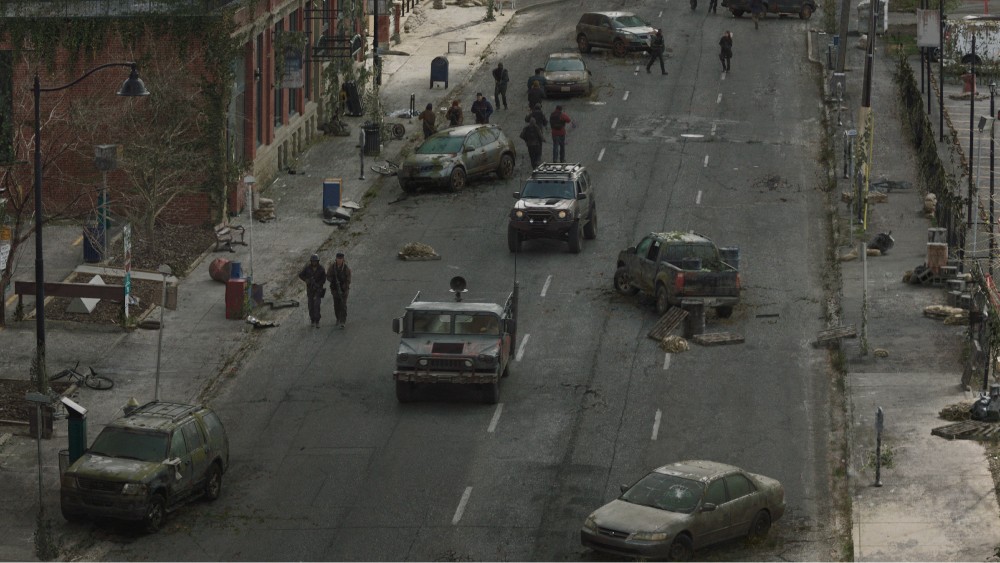
BTL: Did you work with the production designer as well? When you have something like this where you’re adding stuff to what was already shot, I imagine that would be a crucial person to work with.
Drain: We did have to do that. We didn’t work directly with the production designer — everything pretty much [came] through Alex. In this case, we were vendor side. When I’ve done work that I’m on the studio side, naturally, there’s a great collaboration there. Alex had that relationship on his side, so the production designer, we would get concept art from them, we would get images from the game. We would get images of stuff they just thought was cool. Maybe it’s not part of the game, but, “Boy, isn’t this awesome? Let’s try to integrate that.” From that aspect, it was quite collaborative, but we worked primarily with Alex and Sean [Nowlan], the digital effects producer.
BTL: Besides foliage, are you also creating military vehicles and things like that, which weren’t on the locations they shot, right? Do you create those from scratch, or are those assets you already have?
Drain: DD, being around as long as they have, and done as much as they have, they have an extensive library. This is where the research end of things came through. I was able to go into the DD library, and [type] “Ships,” and all these ships come up. I’m trying to make a value judgment on what might suit the flavor and the spirit of what they’re looking for. I’d grab all these different elements, and we would prepare a turntable and submit that, and then they would choose the ones that they think would be the most effective.
It was the same with the military vehicles, helicopters, even some stuff as benign as a pile of garbage that we peppered the streets with, with pallets and piles of garbage. Obviously, weeds growing through things. Some of it was library, but some of it wasn’t. Some of it was stuff that they specifically might have wanted, some broken elements within a scene. We would either start with a pre-existing model that we had, and then just refashion it for this work. Or if we needed to, we would just build it from scratch.
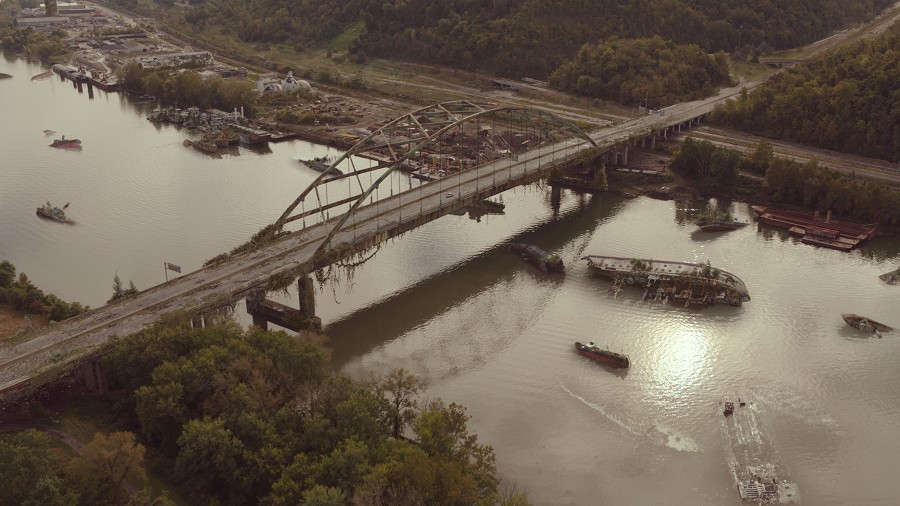
BTL: I think saw there was a train falling off the side of the bridge. Can you talk about that?
Drain: Exactly like that. That went through a couple of iterations. At first, we just felt that would be a freight train up there, but they wanted to tell more of a story of an Amtrak commuter train. We would switch that out, and then we’d look at it and go, “It’s so far off, and it’s so small, let’s make it a double-decker commuter train.” We would do all this editing as we went along.
Again, the production art was a good basis, but they didn’t really go into the storytelling aspect of it, which is something that we tried to do on our side, because that’s what VFX people do. We want it to look like the train tracks fell, and the train fell, so you start making this little story, “Well, if it fell, and gravity grabbed it this way, and it twists this way, it would land over here.” Sometimes, that’s not the most aesthetically pleasing way of doing it, but that’s where we started.
BTL: It’s great to hear that storytelling aspect of it, because when the cameras pass by that shot, you notice it but maybe you don’t think about it too much on the viewer’s end of things.
Drain: The audience might spend 15 to 20 seconds with a shot, often much less, and we’ve spent months with it. Naturally, we go into all of that, and getting back to the idea of the storytelling, of the whole sequence, basically. What we worked on primarily was once they started leaving the city. The game takes a lot of time in the city, and there was a lot of work done within the city walls.
Once you get out of the city, the story starts to become not only what’s happened over the past 20 years, but it’s how it’s seen through Ellie’s eyes. She’s never left the city before, so that was one of the reasons why we did want to have a certain amount of beauty to it, so that she can go, “Oh, my god, wow, look at that.” She’d never seen a train before. She’d never seen an airplane before. She grew up under these conditions. This montage was done of all these different locations that she’s passing, wide-eyed and just being amazed at the sight of a roller coaster. That was part of the story we were trying to tell.
BTL: It’s also world building, especially with something like this and taking all the source material and turning it into something that places the viewer in that time.
Drain: That was the fun part of the job. I enjoy this aspect of it is going even above and beyond a little bit. There are so many little devils in [the] details. If it’s their truck driving down the road, we know the obvious stuff to make things look overgrown, but then you start thinking about, “Well, we gotta break up the pavement a little bit. It hasn’t been maintained for 20 years.” So you start putting cracks in the pavement, and you’re like, “Well, wait a minute. It hasn’t even been cleaned for 20 years.” So you have this truck driving over it, so it should be picking up leaves and dirt and grit.
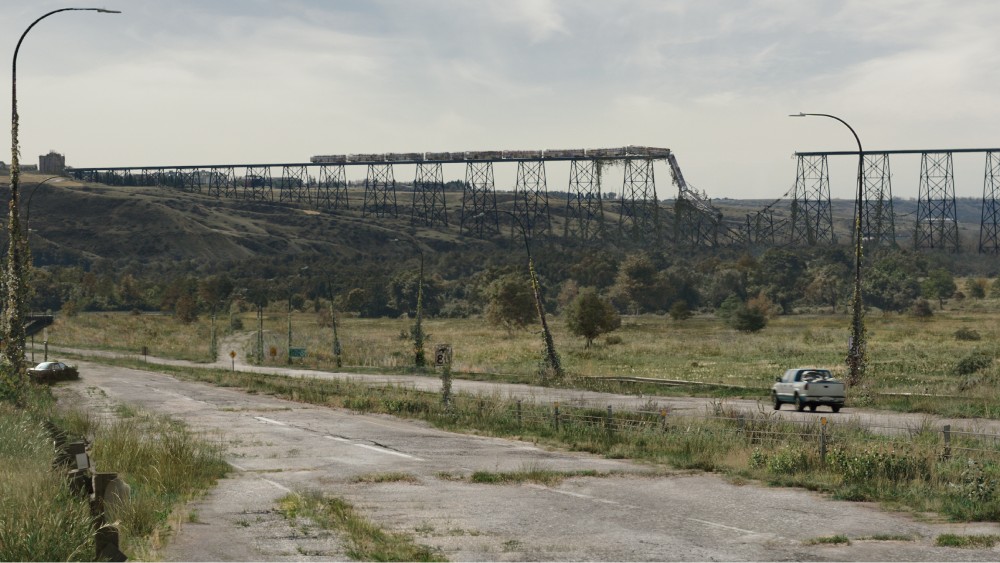
BTL: Were there a lot of animation elements involved with this part of the show’s VFX?
Drain: There was some. They were very clever how they shot it. We were able to optimize the work we were putting in, because we didn’t have to do a whole lot of massive perspective. Even though most of the elements were three-dimensional, it had this nodal feel to it, and everything in some shots worked in a very 2D way. But yes, we wanted to make sure that foliage was subtly wafting in the wind. If you put a tree in the background, and it’s static, it’s just sitting there, not doing anything, people see that, and they lock right into it. You have to put a subtle bit of movement into those branches and those leaves.
Actually having water in the bridge shot, going over the bridge, we put all the capsized boats and sailboats and all that. But there are water currents, so that water current has to be moving past these objects and collide and go around them. Again, it’s super subtle. If it wasn’t there, everybody would be screaming, “FAKE!” If it is there, nobody notices. That’s what you want. You don’t really want them going, “Oh, look at the great visual effects.” You want them buying into the story.
It was mostly environmental movements and things like that. We didn’t have to animate vehicles or anything like that, because the field of tanks and helicopters was intended to be abandoned, so we didn’t really have to animate any of that stuff. We just had to make it look like it’s been sitting there for 20 years.
BTL: I assume Digital Domain was able to transition quickly to at-home work for COVID, but I’m also curious about how VFX seems to have fallen behind maybe because there was too much work to do with not enough people to do it. How’s your experience been?
Drain: I feel like it’s a bit of everything, not to hedge the answer, but back in March of 2020, when the word came down we have to transition to work from home. Naturally, any company, especially a company like Digital Domain, who had so much work in the hopper… It’s like, this is the last thing we need when we’re trying to deliver shows and all of that. I was working on Perry Mason at the time, I think. I had a couple of things going on, but regardless, I don’t know how they did it. Hats off to the engineering staff and the systems administrators at DD. By Monday, I was able to log in to my machine at the shop from home and work. Was it the fastest? Probably not. Were there bugs? Yes. But I was amazed and impressed at how quickly we were able to get back up to speed.
In fact, the HBO clients on Perry Mason, complimented us, through me, that they didn’t even know we went home. They never felt it. Granted, that wasn’t a giant Marvel spectacle that may have taken some hits, but in my corner of DD, it was a successful transition. We really didn’t miss any deadlines. I have to say all the clients, too, were very understanding. They knew what was going on, and it was like, “Hey, we got a temp screening on this day. Give us what you can.” We don’t usually get that kind of bandwidth, but we got that, and naturally, that helped.
The company was surprisingly nimble, and then, I didn’t feel much of a slowdown, I have to be honest. I really didn’t sense too much of a slowdown. Things have gotten a little slower early on this year, after I delivered The Last of Us. We’re now more in a bidding phase, because a lot of shows are still in production, but they’re all starting to deliver at the same time. Now, with the writers strike, things remain to be seen, but we’re bidding quite heavily now. Regardless of any writers strike or any of that, there is a lot in the works.
The first season of The Last of Us is available to stream on Max.





